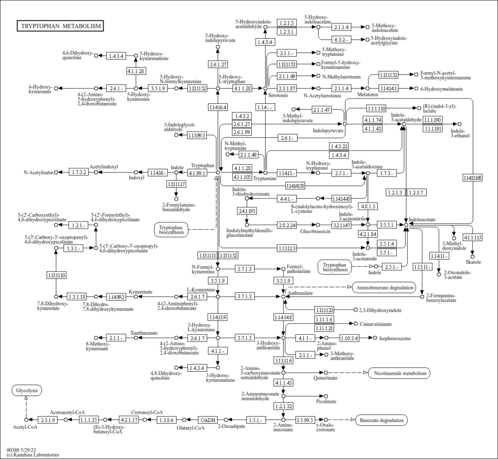| 4-(2-Aminophenyl)-2,4-dioxobutanoic acid,1TMS,isomer #1 | C[Si](C)(C)OC(=O)C(=O)CC(=O)C1=CC=CC=C1N | 1986.3 | Semi standard non polar | 33892256 |
| 4-(2-Aminophenyl)-2,4-dioxobutanoic acid,1TMS,isomer #2 | C[Si](C)(C)OC(=CC(=O)C1=CC=CC=C1N)C(=O)O | 2158.7 | Semi standard non polar | 33892256 |
| 4-(2-Aminophenyl)-2,4-dioxobutanoic acid,1TMS,isomer #3 | C[Si](C)(C)NC1=CC=CC=C1C(=O)CC(=O)C(=O)O | 2094.6 | Semi standard non polar | 33892256 |
| 4-(2-Aminophenyl)-2,4-dioxobutanoic acid,2TMS,isomer #1 | C[Si](C)(C)OC(=O)C(=CC(=O)C1=CC=CC=C1N)O[Si](C)(C)C | 2136.6 | Semi standard non polar | 33892256 |
| 4-(2-Aminophenyl)-2,4-dioxobutanoic acid,2TMS,isomer #1 | C[Si](C)(C)OC(=O)C(=CC(=O)C1=CC=CC=C1N)O[Si](C)(C)C | 1983.5 | Standard non polar | 33892256 |
| 4-(2-Aminophenyl)-2,4-dioxobutanoic acid,2TMS,isomer #1 | C[Si](C)(C)OC(=O)C(=CC(=O)C1=CC=CC=C1N)O[Si](C)(C)C | 2779.1 | Standard polar | 33892256 |
| 4-(2-Aminophenyl)-2,4-dioxobutanoic acid,2TMS,isomer #2 | C[Si](C)(C)NC1=CC=CC=C1C(=O)CC(=O)C(=O)O[Si](C)(C)C | 2079.3 | Semi standard non polar | 33892256 |
| 4-(2-Aminophenyl)-2,4-dioxobutanoic acid,2TMS,isomer #2 | C[Si](C)(C)NC1=CC=CC=C1C(=O)CC(=O)C(=O)O[Si](C)(C)C | 2019.0 | Standard non polar | 33892256 |
| 4-(2-Aminophenyl)-2,4-dioxobutanoic acid,2TMS,isomer #2 | C[Si](C)(C)NC1=CC=CC=C1C(=O)CC(=O)C(=O)O[Si](C)(C)C | 2462.1 | Standard polar | 33892256 |
| 4-(2-Aminophenyl)-2,4-dioxobutanoic acid,2TMS,isomer #3 | C[Si](C)(C)NC1=CC=CC=C1C(=O)C=C(O[Si](C)(C)C)C(=O)O | 2201.5 | Semi standard non polar | 33892256 |
| 4-(2-Aminophenyl)-2,4-dioxobutanoic acid,2TMS,isomer #3 | C[Si](C)(C)NC1=CC=CC=C1C(=O)C=C(O[Si](C)(C)C)C(=O)O | 2105.4 | Standard non polar | 33892256 |
| 4-(2-Aminophenyl)-2,4-dioxobutanoic acid,2TMS,isomer #3 | C[Si](C)(C)NC1=CC=CC=C1C(=O)C=C(O[Si](C)(C)C)C(=O)O | 2646.2 | Standard polar | 33892256 |
| 4-(2-Aminophenyl)-2,4-dioxobutanoic acid,2TMS,isomer #4 | C[Si](C)(C)N(C1=CC=CC=C1C(=O)CC(=O)C(=O)O)[Si](C)(C)C | 2047.4 | Semi standard non polar | 33892256 |
| 4-(2-Aminophenyl)-2,4-dioxobutanoic acid,2TMS,isomer #4 | C[Si](C)(C)N(C1=CC=CC=C1C(=O)CC(=O)C(=O)O)[Si](C)(C)C | 2151.3 | Standard non polar | 33892256 |
| 4-(2-Aminophenyl)-2,4-dioxobutanoic acid,2TMS,isomer #4 | C[Si](C)(C)N(C1=CC=CC=C1C(=O)CC(=O)C(=O)O)[Si](C)(C)C | 2581.7 | Standard polar | 33892256 |
| 4-(2-Aminophenyl)-2,4-dioxobutanoic acid,3TMS,isomer #1 | C[Si](C)(C)NC1=CC=CC=C1C(=O)C=C(O[Si](C)(C)C)C(=O)O[Si](C)(C)C | 2218.4 | Semi standard non polar | 33892256 |
| 4-(2-Aminophenyl)-2,4-dioxobutanoic acid,3TMS,isomer #1 | C[Si](C)(C)NC1=CC=CC=C1C(=O)C=C(O[Si](C)(C)C)C(=O)O[Si](C)(C)C | 2100.8 | Standard non polar | 33892256 |
| 4-(2-Aminophenyl)-2,4-dioxobutanoic acid,3TMS,isomer #1 | C[Si](C)(C)NC1=CC=CC=C1C(=O)C=C(O[Si](C)(C)C)C(=O)O[Si](C)(C)C | 2449.3 | Standard polar | 33892256 |
| 4-(2-Aminophenyl)-2,4-dioxobutanoic acid,3TMS,isomer #2 | C[Si](C)(C)OC(=O)C(=O)CC(=O)C1=CC=CC=C1N([Si](C)(C)C)[Si](C)(C)C | 2070.1 | Semi standard non polar | 33892256 |
| 4-(2-Aminophenyl)-2,4-dioxobutanoic acid,3TMS,isomer #2 | C[Si](C)(C)OC(=O)C(=O)CC(=O)C1=CC=CC=C1N([Si](C)(C)C)[Si](C)(C)C | 2109.2 | Standard non polar | 33892256 |
| 4-(2-Aminophenyl)-2,4-dioxobutanoic acid,3TMS,isomer #2 | C[Si](C)(C)OC(=O)C(=O)CC(=O)C1=CC=CC=C1N([Si](C)(C)C)[Si](C)(C)C | 2288.8 | Standard polar | 33892256 |
| 4-(2-Aminophenyl)-2,4-dioxobutanoic acid,3TMS,isomer #3 | C[Si](C)(C)OC(=CC(=O)C1=CC=CC=C1N([Si](C)(C)C)[Si](C)(C)C)C(=O)O | 2187.8 | Semi standard non polar | 33892256 |
| 4-(2-Aminophenyl)-2,4-dioxobutanoic acid,3TMS,isomer #3 | C[Si](C)(C)OC(=CC(=O)C1=CC=CC=C1N([Si](C)(C)C)[Si](C)(C)C)C(=O)O | 2246.3 | Standard non polar | 33892256 |
| 4-(2-Aminophenyl)-2,4-dioxobutanoic acid,3TMS,isomer #3 | C[Si](C)(C)OC(=CC(=O)C1=CC=CC=C1N([Si](C)(C)C)[Si](C)(C)C)C(=O)O | 2493.2 | Standard polar | 33892256 |
| 4-(2-Aminophenyl)-2,4-dioxobutanoic acid,4TMS,isomer #1 | C[Si](C)(C)OC(=O)C(=CC(=O)C1=CC=CC=C1N([Si](C)(C)C)[Si](C)(C)C)O[Si](C)(C)C | 2204.8 | Semi standard non polar | 33892256 |
| 4-(2-Aminophenyl)-2,4-dioxobutanoic acid,4TMS,isomer #1 | C[Si](C)(C)OC(=O)C(=CC(=O)C1=CC=CC=C1N([Si](C)(C)C)[Si](C)(C)C)O[Si](C)(C)C | 2195.9 | Standard non polar | 33892256 |
| 4-(2-Aminophenyl)-2,4-dioxobutanoic acid,4TMS,isomer #1 | C[Si](C)(C)OC(=O)C(=CC(=O)C1=CC=CC=C1N([Si](C)(C)C)[Si](C)(C)C)O[Si](C)(C)C | 2299.1 | Standard polar | 33892256 |
| 4-(2-Aminophenyl)-2,4-dioxobutanoic acid,1TBDMS,isomer #1 | CC(C)(C)[Si](C)(C)OC(=O)C(=O)CC(=O)C1=CC=CC=C1N | 2242.1 | Semi standard non polar | 33892256 |
| 4-(2-Aminophenyl)-2,4-dioxobutanoic acid,1TBDMS,isomer #2 | CC(C)(C)[Si](C)(C)OC(=CC(=O)C1=CC=CC=C1N)C(=O)O | 2417.8 | Semi standard non polar | 33892256 |
| 4-(2-Aminophenyl)-2,4-dioxobutanoic acid,1TBDMS,isomer #3 | CC(C)(C)[Si](C)(C)NC1=CC=CC=C1C(=O)CC(=O)C(=O)O | 2361.4 | Semi standard non polar | 33892256 |
| 4-(2-Aminophenyl)-2,4-dioxobutanoic acid,2TBDMS,isomer #1 | CC(C)(C)[Si](C)(C)OC(=O)C(=CC(=O)C1=CC=CC=C1N)O[Si](C)(C)C(C)(C)C | 2614.6 | Semi standard non polar | 33892256 |
| 4-(2-Aminophenyl)-2,4-dioxobutanoic acid,2TBDMS,isomer #1 | CC(C)(C)[Si](C)(C)OC(=O)C(=CC(=O)C1=CC=CC=C1N)O[Si](C)(C)C(C)(C)C | 2352.9 | Standard non polar | 33892256 |
| 4-(2-Aminophenyl)-2,4-dioxobutanoic acid,2TBDMS,isomer #1 | CC(C)(C)[Si](C)(C)OC(=O)C(=CC(=O)C1=CC=CC=C1N)O[Si](C)(C)C(C)(C)C | 2897.1 | Standard polar | 33892256 |
| 4-(2-Aminophenyl)-2,4-dioxobutanoic acid,2TBDMS,isomer #2 | CC(C)(C)[Si](C)(C)NC1=CC=CC=C1C(=O)CC(=O)C(=O)O[Si](C)(C)C(C)(C)C | 2540.1 | Semi standard non polar | 33892256 |
| 4-(2-Aminophenyl)-2,4-dioxobutanoic acid,2TBDMS,isomer #2 | CC(C)(C)[Si](C)(C)NC1=CC=CC=C1C(=O)CC(=O)C(=O)O[Si](C)(C)C(C)(C)C | 2478.6 | Standard non polar | 33892256 |
| 4-(2-Aminophenyl)-2,4-dioxobutanoic acid,2TBDMS,isomer #2 | CC(C)(C)[Si](C)(C)NC1=CC=CC=C1C(=O)CC(=O)C(=O)O[Si](C)(C)C(C)(C)C | 2709.4 | Standard polar | 33892256 |
| 4-(2-Aminophenyl)-2,4-dioxobutanoic acid,2TBDMS,isomer #3 | CC(C)(C)[Si](C)(C)NC1=CC=CC=C1C(=O)C=C(O[Si](C)(C)C(C)(C)C)C(=O)O | 2683.6 | Semi standard non polar | 33892256 |
| 4-(2-Aminophenyl)-2,4-dioxobutanoic acid,2TBDMS,isomer #3 | CC(C)(C)[Si](C)(C)NC1=CC=CC=C1C(=O)C=C(O[Si](C)(C)C(C)(C)C)C(=O)O | 2532.4 | Standard non polar | 33892256 |
| 4-(2-Aminophenyl)-2,4-dioxobutanoic acid,2TBDMS,isomer #3 | CC(C)(C)[Si](C)(C)NC1=CC=CC=C1C(=O)C=C(O[Si](C)(C)C(C)(C)C)C(=O)O | 2835.2 | Standard polar | 33892256 |
| 4-(2-Aminophenyl)-2,4-dioxobutanoic acid,2TBDMS,isomer #4 | CC(C)(C)[Si](C)(C)N(C1=CC=CC=C1C(=O)CC(=O)C(=O)O)[Si](C)(C)C(C)(C)C | 2530.5 | Semi standard non polar | 33892256 |
| 4-(2-Aminophenyl)-2,4-dioxobutanoic acid,2TBDMS,isomer #4 | CC(C)(C)[Si](C)(C)N(C1=CC=CC=C1C(=O)CC(=O)C(=O)O)[Si](C)(C)C(C)(C)C | 2533.0 | Standard non polar | 33892256 |
| 4-(2-Aminophenyl)-2,4-dioxobutanoic acid,2TBDMS,isomer #4 | CC(C)(C)[Si](C)(C)N(C1=CC=CC=C1C(=O)CC(=O)C(=O)O)[Si](C)(C)C(C)(C)C | 2729.0 | Standard polar | 33892256 |
| 4-(2-Aminophenyl)-2,4-dioxobutanoic acid,3TBDMS,isomer #1 | CC(C)(C)[Si](C)(C)NC1=CC=CC=C1C(=O)C=C(O[Si](C)(C)C(C)(C)C)C(=O)O[Si](C)(C)C(C)(C)C | 2876.0 | Semi standard non polar | 33892256 |
| 4-(2-Aminophenyl)-2,4-dioxobutanoic acid,3TBDMS,isomer #1 | CC(C)(C)[Si](C)(C)NC1=CC=CC=C1C(=O)C=C(O[Si](C)(C)C(C)(C)C)C(=O)O[Si](C)(C)C(C)(C)C | 2660.7 | Standard non polar | 33892256 |
| 4-(2-Aminophenyl)-2,4-dioxobutanoic acid,3TBDMS,isomer #1 | CC(C)(C)[Si](C)(C)NC1=CC=CC=C1C(=O)C=C(O[Si](C)(C)C(C)(C)C)C(=O)O[Si](C)(C)C(C)(C)C | 2787.6 | Standard polar | 33892256 |
| 4-(2-Aminophenyl)-2,4-dioxobutanoic acid,3TBDMS,isomer #2 | CC(C)(C)[Si](C)(C)OC(=O)C(=O)CC(=O)C1=CC=CC=C1N([Si](C)(C)C(C)(C)C)[Si](C)(C)C(C)(C)C | 2728.4 | Semi standard non polar | 33892256 |
| 4-(2-Aminophenyl)-2,4-dioxobutanoic acid,3TBDMS,isomer #2 | CC(C)(C)[Si](C)(C)OC(=O)C(=O)CC(=O)C1=CC=CC=C1N([Si](C)(C)C(C)(C)C)[Si](C)(C)C(C)(C)C | 2715.1 | Standard non polar | 33892256 |
| 4-(2-Aminophenyl)-2,4-dioxobutanoic acid,3TBDMS,isomer #2 | CC(C)(C)[Si](C)(C)OC(=O)C(=O)CC(=O)C1=CC=CC=C1N([Si](C)(C)C(C)(C)C)[Si](C)(C)C(C)(C)C | 2651.1 | Standard polar | 33892256 |
| 4-(2-Aminophenyl)-2,4-dioxobutanoic acid,3TBDMS,isomer #3 | CC(C)(C)[Si](C)(C)OC(=CC(=O)C1=CC=CC=C1N([Si](C)(C)C(C)(C)C)[Si](C)(C)C(C)(C)C)C(=O)O | 2833.3 | Semi standard non polar | 33892256 |
| 4-(2-Aminophenyl)-2,4-dioxobutanoic acid,3TBDMS,isomer #3 | CC(C)(C)[Si](C)(C)OC(=CC(=O)C1=CC=CC=C1N([Si](C)(C)C(C)(C)C)[Si](C)(C)C(C)(C)C)C(=O)O | 2793.6 | Standard non polar | 33892256 |
| 4-(2-Aminophenyl)-2,4-dioxobutanoic acid,3TBDMS,isomer #3 | CC(C)(C)[Si](C)(C)OC(=CC(=O)C1=CC=CC=C1N([Si](C)(C)C(C)(C)C)[Si](C)(C)C(C)(C)C)C(=O)O | 2783.0 | Standard polar | 33892256 |
| 4-(2-Aminophenyl)-2,4-dioxobutanoic acid,4TBDMS,isomer #1 | CC(C)(C)[Si](C)(C)OC(=O)C(=CC(=O)C1=CC=CC=C1N([Si](C)(C)C(C)(C)C)[Si](C)(C)C(C)(C)C)O[Si](C)(C)C(C)(C)C | 3029.1 | Semi standard non polar | 33892256 |
| 4-(2-Aminophenyl)-2,4-dioxobutanoic acid,4TBDMS,isomer #1 | CC(C)(C)[Si](C)(C)OC(=O)C(=CC(=O)C1=CC=CC=C1N([Si](C)(C)C(C)(C)C)[Si](C)(C)C(C)(C)C)O[Si](C)(C)C(C)(C)C | 2870.8 | Standard non polar | 33892256 |
| 4-(2-Aminophenyl)-2,4-dioxobutanoic acid,4TBDMS,isomer #1 | CC(C)(C)[Si](C)(C)OC(=O)C(=CC(=O)C1=CC=CC=C1N([Si](C)(C)C(C)(C)C)[Si](C)(C)C(C)(C)C)O[Si](C)(C)C(C)(C)C | 2708.4 | Standard polar | 33892256 |
